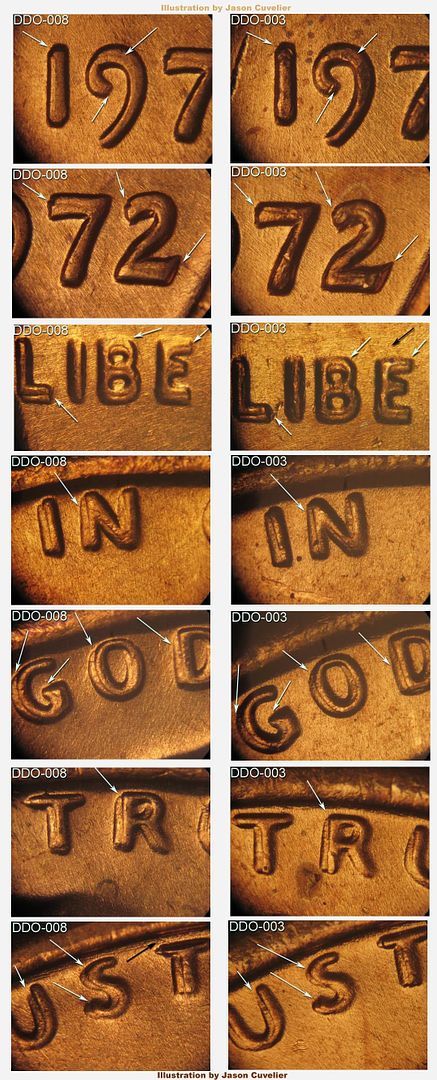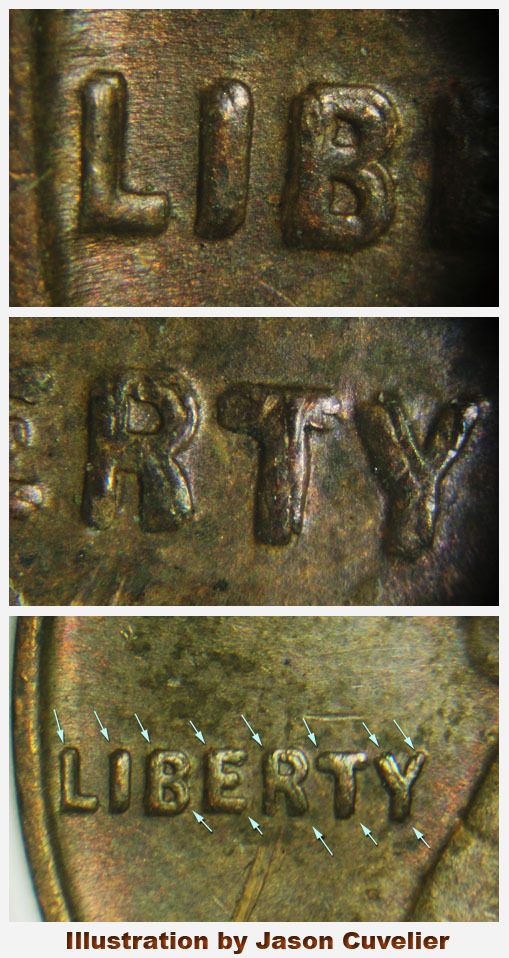Doubled Dies: Class I (Rotated hub Doubling) (LINK):
Probably the easiest to conceptualize and diagnose. It is simply two separate hubbings, where the second hubbing has been rotated in relation to the first hubbing at or near the center point of the die. They are listed as clockwise (CW) or counter-clockwise (CCW) which pertains to the order in which hubbings were made; the deeper hubbing, which appears visually on top of the first, is typically regarded as the second hubbing.
Doubling is typically found to be rounded, with notching, seperation lines and extra thickness.
Below is a overlay diagram of a fictitious Class I Doubled Die that has a CW rotated spread similar to the King of Doubled Dies, the 1955P DDO-001. Notice how the spread is equal on all devices and increases further out from the center of the coin.
Below are photos of 1972P DDO-001, a Class I DDO with a strong CW spread on all outside devices and parts of the vest. Due to the way a second hubbing eliminates parts of the design impressed from the first hubbing, doubling typically only shows in areas that remain open in the new orientation of the die, thus, only the outside elements of the portrait of Lincoln and the motto show doubling while the center points are lost to the second hubbing.
You can see on the first hubbing G (1.) was entered along with the rest of the design, then the second hubbing was oriented CW to the first and the second G (2.) was hubbed. The second G visual appears to be sitting on the first G.
Below you can see clear separation between the letters in the motto.
Below is distinctive notching on the upper and lower serifs of the date (the 1 is highlighted).
Below is a Class I Doubled Die on the reverse, listed as 1964P DDR-001, it shows a CCW spread. Again there is clear separation, notches and rounded doubling - it is strongest in STATES and of. Notice that while all devices show some doubling, the upper motto is the strongest, this is due to the pivot point between hubbings, while near the center, being located over the steps rather than the absolute middle of the die.
LINKS to other Classes:
Class II
Class III
Class IV
Class V
Welcome guest, is this your first visit? Click the "Create Account" button now to join.
Results 1 to 10 of 18
Thread: Class I (Rotated Hub Doubling)
Hybrid View
-
11-22-2009 #1
Class I (Rotated Hub Doubling)
Last edited by jcuve; 05-11-2012 at 08:55 PM.
Jason Cuvelier
MadDieClashes.com - ErrorVariety.com
TrailDies.com - Error-ref.com - Port.Cuvelier.org
CONECA
(images © Jason Cuvelier 2008-18)___________________
-
Post Thanks / Like - 1 Thanks, 0 Likes
 Lunstedt thanked for this post
Lunstedt thanked for this post
-
11-22-2009 #2
A side by side of two strong CW Class I DDOs: 1972 DDO-008 & DDO-003.

1936 DDO-001 also with strong separation:


Last edited by jcuve; 07-30-2012 at 08:30 PM.
Jason Cuvelier
MadDieClashes.com - ErrorVariety.com
TrailDies.com - Error-ref.com - Port.Cuvelier.org
CONECA
(images © Jason Cuvelier 2008-18)___________________
-
Post Thanks / Like - 1 Thanks, 0 Likes
 Lunstedt thanked for this post
Lunstedt thanked for this post
-
11-22-2009 #3
Another example of Class I doubling can be found on 1941P DDO-001.

Last edited by jcuve; 05-11-2012 at 08:52 PM.
Jason Cuvelier
MadDieClashes.com - ErrorVariety.com
TrailDies.com - Error-ref.com - Port.Cuvelier.org
CONECA
(images © Jason Cuvelier 2008-18)___________________
-
12-29-2009 #4MintyFreshGuest
This is exactly what I have been looking for. Great pics Jason - you are an artist...
-
12-29-2009 #5
-
08-16-2010 #6
Notches
NOTCHES:
A notch from hub doubling is the product of overlapping parts of a device that drop off in relation to one another. Notches are most often seen at corners and with serifs.
Now for example if a die shows hub doubling and there is a geographic shift in relation to the rotation (north, south, east or west), the notches will be more apparent. The proceeding illustration shows a CCW rotation with the Red being the first hubbing and the Green the second - the green is also slightly south (or down in relation to the red). While the spread is minor, the notches are obvious as the drop offs are throughout much of the doubling. Even the round parts (like the o and S) show an ellipse that ever so gently comes inward as opposed to straight lines that would be seen with MD.

Now we will see a stronger CCW spread that does not show a significant geographic change in position, the result is fewer notches, but where the design drops off, such as the serifs on the S or the top of the A, there will be minor notching or splits seen.

Next is some notching diagrams to give one an idea of where (and the variety of places) Class I (and also Class V) hub doubling can produce notches.

Below is a nice Class I DDO, listed as 1941P DDO-002. You can see strong rounded doubling and separation lines on all devices - strongest in IGWT, but the notching is harder to perceive.

Last edited by jcuve; 05-11-2012 at 09:00 PM.
Jason Cuvelier
MadDieClashes.com - ErrorVariety.com
TrailDies.com - Error-ref.com - Port.Cuvelier.org
CONECA
(images © Jason Cuvelier 2008-18)___________________
-
11-22-2009 #7
I am not seeing your photos in the first part of the thread Jason. Trouble with the host folks again?
Bob Piazza
Former Lincoln Cent Attributer Coppercoins.com
-
11-22-2009 #8
Thanks Jean! BTW if I make a mistake let me know...
Bob, my sever has a bad period every couple of hours and you keep hitting those down times...sorry, you're missing the best part of my thread (again)
It's $7 a month, but I think soon I'll just have to move the 500mb of my paintings and photographs somewhere else as this is getting ridiculous...
Jason Cuvelier
MadDieClashes.com - ErrorVariety.com
TrailDies.com - Error-ref.com - Port.Cuvelier.org
CONECA
(images © Jason Cuvelier 2008-18)___________________
-
11-22-2009 #9jpl6332Guest
Very, Very, Very Nice Photos Jason and an excellent tutorial. These tutorials will prove to be an exceptional aid to newbies and to seasoned collectors as well. It would be really cool to actually see a diagram of the hubbing process similar to pages 71-82 of the plaid book. But with all of the phases of the hubbing process. It would be a lot of work though. Are these tutorials going to be posted online? I mean besides in these forum pages.
Thank you,
JeffLast edited by jpl6332; 11-22-2009 at 03:53 PM.
-
11-22-2009 #10
Thanks Jeff! I already have it posted online: http://www.errorvariety.com/Doubled-dies/class01.html (others to follow later)...
Thanks again Bob! I have some of the illustrations done for classes I-VI; I don't have good examples of class VII on hand; and class VIII and IX present challenges as far as an explanation...and then there's how to illustrate them...I have time to work it out...Last edited by jcuve; 08-16-2010 at 07:09 PM.
Jason Cuvelier
MadDieClashes.com - ErrorVariety.com
TrailDies.com - Error-ref.com - Port.Cuvelier.org
CONECA
(images © Jason Cuvelier 2008-18)___________________














 Reply With Quote
Reply With Quote

Bookmarks